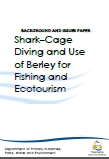Discussion paper on shark cage diving released by Tasmania
News Release
Department of Primary Industries, Parks, Water and Environment / Tasmania
October 2012
Shark-Cage Diving and Use of Berley for Fishing and Ecotourism
Public comments are invited by 31 October 2012. A paper canvassing views regarding the regulation of shark-cage diving and associated activities.
There has been speculation regarding the possible development of a shark-cage diving tourism operation in south-east Tasmania. While there is no commercial operation at present, the possibility of such an operation raises the issue of actively seeking to attract sharks, something that is done by other users of the marine environment for the purpose of fishing.
The paper below has been developed to canvass the views of stakeholders and the community in relation to the regulation of shark-cage diving and associated activities.
Shark-cage diving involves observing large sharks at proximity under the water from the safety of a cage attached to a vessel – the Great White Shark being the targeted species.
There are questions about the risks associated with attracting large sharks or habituating sharks to popular areas.
User groups that may overlap with shark-cage diving operations include: eco-diving operations; recreational divers (extractive/non-extractive); commercial divers (e.g., abalone divers); and swimmers.
There are no rules under the Living Marine Resources Management Act 1995 that restrict shark-cage diving. However, there are powers under the Act that could be used to restrict or prohibit shark-cage diving. The introduction of any such legislation would need to follow the processes stipulated by the Act, including public consultation.
 PDF – DOWNLOAD
PDF – DOWNLOAD
Persons wishing to comment on this paper should write to:
The Director
Marine Resources
GPO Box 44
HOBART TAS 7001
Email: Fishing.Enquiries@dpipwe.tas.gov.au
Attention: Director, Marine Resources,
Shark-Cage Diving Comment
Please submit any comments by Wednesday, 31 October 2012.
Source: DPIPWE
